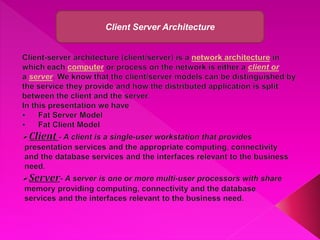
Fat vs Thin Client Server Models Explained
- 2. The Fat Server Model Place more functions on the server Usually used for the mission-critical applications. Applications are easier to manage on the network as most of the work is done on the server. The fat servers create abstract level of services by which the network interchange is minimized. The Transaction Servers and the Object Server embed the concept of encapsulation of database by exporting the procedure/ methods, which act on the data instead of the raw data. The client interacts with such fat servers using the remote procedure call. The examples are the Groupware, Transaction Servers, and Web Servers.
- 3. Fat Client Model Places more function on the client. In a client/server architecture, a client that performs the bulk of the data processing operations. The data itself is stored on the server. They are the traditional form of the client/server systems They are generally used for decision support and personal software They lead to the creation of the front-end tools and applications. The best places are – the file server and the database server models where the client knows how the data is organized and stored on the server.
- 4. The Architectures A network architecture in which each computer or process on the network is either a client or a server. Servers are powerful computers or processes dedicated to managing disk drives (file servers), printers (print servers), or network traffic (network servers ). Clients are PCs or workstations on which users run applications. Clients rely on servers for resources, such as files, devices, and even processing power.
- 6. The Architectures Another type of network architecture is known as a peer-to-peer architecture because each node has equivalent responsibilities. Both client/server and peer-to-peer architectures are widely used, and each has unique advantages and disadvantages. Client-server architectures are sometimes called two-tier architectures. The gurus of the client/server architecture do not use the terms fat client and the fat servers on the contrary they refer to them are 2-tier, 3-tier and N-tier client/server architecture. This is the means by which they are functionally split. The functional units comprise of user interface, business logic and the shared data.
- 7. 2-tier Client/Server Architecture Two tier software architectures were developed in the 1980s from the file server software architecture design. The two-tier architecture is intended to improve usability by supporting a forms-based, user-friendly interface. The two-tier architecture improves scalability by accommodating up to 100 users (file server architectures only accommodate a dozen users). It also proves flexibility by allowing data to be shared, usually within a homogeneous environment.
- 9. Two tier architectures consist of three components distributed in two layers: client (requester of services) server (provider of services). The three components are User System Interface (such as session, text input, dialog, and display management services) Processing Management (such as process development, process enactment, process monitoring, and process resource services) Database Management (such as data and file services)
- 10. Advantages of 2-tier Client/Server Architecture Easy to maintain and modification is bit easy Communication is faster Disadvantage of 2-tier Client/Server Architecture In two tier architecture application performance will be degrade upon increasing the users. Cost-ineffective
- 11. 3-tier Client/Server Architecture The three-tier software architecture emerged in the 1990s to overcome the limitations of the two-tier architecture. The third tier (middle tier server) is between the user interface (client) and the data management (server) components. The three tier architecture is used when an effective distributed client/server design is needed that provides (when compared to the two tier) increased performance, flexibility, maintainability, reusability, and scalability, while hiding the complexity of distributed processing from the user.
- 14. Advantages of 3-tier Client/Server Architecture High performance, lightweight persistent objects Scalability – Each tier can scale horizontally Performance – Because the Presentation tier can cache requests, network utilization is minimized, and the load is reduced on the Application and Data tiers. High degree of flexibility in deployment platform and configuration Better Re-use Improve Data Integrity Improved Security – Client is not direct access to database. Easy to maintain and modification is bit easy, won’t affect other modules In three tier architecture application performance is good.
- 15. Disadvantage of 3-tier Client/Server Architecture Increase Complexity/Effort Characteristics of the Client and the Server Service Shared Resources Scalability Integrity Message-based exchanges
- 16. S. No Two-tier Architecture Three -tier Architecture 1 Client -Server Architecture Web -based application 2 Client will hit request directly to server and client will get response directly from server Here in between client and server middle ware will be there, if client hits a request it will go to the middle ware and middle ware will send to server and vice versa. 3 2-tier means 1) Design layer 2) Data layer 3-tier means 1) Design layer 2) Business layer or Logic layer 3) Data layer
Editor's Notes
- The server process is a provider of services. The client is a consumer of services. A server can service many clients at the same time and regulate their access to shared resources. Client/Server systems can be scaled horizontally or vertically. Horizontal scaling means adding or removing client workstations with only a slight performance impact. Vertical scaling means either migrating to a larger and faster server machine or distributing the processing load across multiple servers. The server code and server data is centrally managed, which results in cheaper maintenance and the guarding of shared data integrity. At the same time, the clients remain personal and independent. Clients and servers are loosely coupled systems that interact through a message-passing mechanism. The message is the delivery mechanism for the service request and replies.